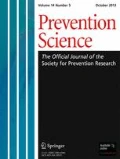Abstract
Researchers often hypothesize that a causal variable, whether randomly assigned or not, has an effect on an outcome behavior and that this effect may vary across levels of initial risk of engaging in the outcome behavior. In this paper, we propose a method for quantifying initial risk status. We then illustrate the use of this risk-status variable as a moderator of the causal effect of leisure boredom, a non-randomized continuous variable, on cigarette smoking initiation. The data come from the HealthWise South Africa study. We define the causal effects using marginal structural models and estimate the causal effects using inverse propensity weights. Indeed, we found leisure boredom had a differential causal effect on smoking initiation across different risk statuses. The proposed method may be useful for prevention scientists evaluating causal effects that may vary across levels of initial risk.

Similar content being viewed by others
References
Aiken, L. S., & West, S. G. (1991). Multiple regression: Testing and interpreting interactions. Thousand Oaks, CA: Sage.
Barber, J. S., Murphy, S. A., & Verbitsky, N. (2004). Adjusting for time-varying confounding in survival analysis. Sociological Methodology, 34, 163–192.
Bray, B. C., Almirall, D., Zimmerman, R. S., Lynam, D., & Murphy, S. A. (2006). Assessing the total effect of time-varying predictors in prevention research. Prevention Science, 7, 1–17.
Brumback, B. A., Hernan, M. A., Hanseuse, S. J. P. S., & Robins, J. M. (2004). Sensitivity analysis for unmeasured confounding assuming a marginal structural model for repeated measures. Statistics in Medicine, 23, 749–767.
Caldwell, L. L., Smith, E., Flisher, A. J., Wegner, L., Vergnani, T., Mathews, C., & Mpofu, E. (2004). HealthWise South Africa: Development of a life skills curriculum for young adults. World Leisure Journal, 46, 4–17.
Cohen, J. (1988). Statistical power analysis for the behavioral sciences. Mahwah, NJ: Lawrence Erlbaum Associates.
Cole, S. R., & Hernan, M. A. (2008). Constructing inverse probability weights for marginal structural models. American Journal of Epidemiology, 168, 656–664.
Hirano, K., & Imbens, G. W. (2004). The propensity score with continuous treatments. In A. Gelman & X.-L. Meng (Eds.), Applied Bayesian modeling and causal inference from incomplete-data perspectives (pp. 73–84). Hoboken, NJ: Wiley.
Hong, G., & Raudenbush, S. W. (2005). Effects of kindergarten retention policy on children’s cognitive growth in reading and mathematics. Educational Evaluation and Policy Analysis, 27, 205–224.
Hong, G., & Raudenbush, S. W. (2006). Evaluating kindergarten retention policy: A case study of causal inference for multi-level observational data. Journal of the American Statistical Association, 101, 901–910.
Imai, K., & van Dyk, D. A. (2004). Causal inference with general treatment regimes: Generalizing the propensity score. Journal of the American Statistical Association, 99, 854–866.
Imbens, G. W. (2000). The role of the propensity score in estimating dose-response functions. Biometrika, 83, 706–710.
Little, R. J. A., & Rubin, D. B. (2002). Statistical analysis with missing data. Hoboken, NJ: Wiley.
Lumley, T. (2010). Survey: Analysis of complex survey samples [software manual]. Retrieved from http://CRAN.R-project.org/package=survey (R package version 3.22-1).
MacKinnon, D. P. (2008). Introduction to statistical mediation analysis. Mahwah, NJ: Lawrence Erlbaum Associates.
Robins, J. M., Hernan, M. A., & Brumback, B. A. (2000). Marginal structural models and causal inference in epidemiology. Epidemiology, 11, 550–560.
Rosenbaum, P. R., & Rubin, D. B. (1983). The central role of the propensity score in observational studies for causal effects. Biometrika, 70, 41–55.
Rosenbaum, P. R., & Rubin, D. B. (1984). Reducing bias in observational studies using subclassification on the propensity score. Journal of the American Statistical Association, 79, 516–524.
Rosenbaum, P. R., & Rubin, D. B. (1985). Constructing a control group using multivariate matched sampling methods that incorporate the propensity score. The American Statistician, 39, 33–38.
Rubin, D. B. (1974). Estimating causal effects of treatments in randomized and nonrandomized studies. Journal of Educational Psychology, 66, 688–701.
Rubin, D. B. (2005). Causal inference using potential outcomes: Design, modeling, decisions. Journal of the American Statistical Association, 100, 322–331.
Schafer, J. L. (1997). Analysis of incomplete multivariate data. London, England: Chapman & Hall.
Schafer, J. L., & Kang, J. D. Y. (2008). Average causal effects from non-randomized studies: A practical guide and simulated example. Psychological Methods, 13, 279–313.
van der Wal, W. M., Prins, M., Lumbreras, B., & Geskus, R. B. (2009). A simple g-computation algorithm to quantify the causal effect of a secondary illness on the progression of a chronic disease. Statistics in Medicine, 28, 2325–2337.
Authors’ note
Preparation of this article was supported by NIDA Center Grant P50 DA100075, NIDA R03 DA026543, and NIDDK 5R21DK082858-02. HealthWise was supported by NIDA grant R01 DA01749. The content is solely the responsibility of the authors and does not necessarily represent the official views of the National Institute on Drug Abuse (NIDA), the National Institute on Diabetes and Digestive and Kidney Diseases (NIDDK), or the National Institutes of Health (NIH).
Author information
Authors and Affiliations
Corresponding author
Appendix
Appendix
R Code
The data set is read into R and is called “dat.” The variable c.bored2 is the mean-centered leisure boredom variable and smoke1, smoke2, and smoke3 are the lifetime smoking variables at baseline, 6 months, and 1 year, respectively.

SAS Code
The data set is read into SAS. It is originally called “leisure” and is in the library “atrisk.” The variable cbored2 is the mean-centered leisure boredom variable and smoke1, smoke2, and smoke3 are the lifetime smoking variables at baseline, 6 months, and 1 year, respectively.


Rights and permissions
About this article
Cite this article
Coffman, D.L., Caldwell, L.L. & Smith, E.A. Introducing the At-Risk Average Causal Effect with Application to HealthWise South Africa. Prev Sci 13, 437–447 (2012). https://doi.org/10.1007/s11121-011-0271-0
Published:
Issue Date:
DOI: https://doi.org/10.1007/s11121-011-0271-0


